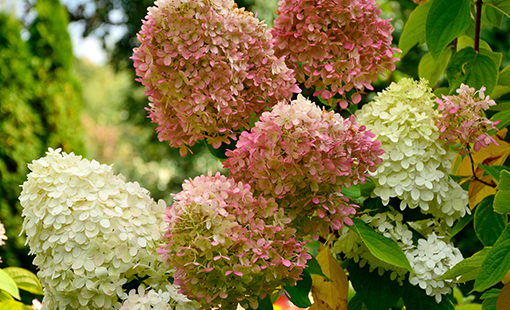
Tree Form Limelight Hydrangea
July 27, 2022
A bold, yet elegant PeeGee Hydrangea selection that has a profusion of blooms. Lime green flowers emerge in July, age to white and continue to evolve to pink and burgundy colors by fall and remain on the plant. A massive bloomer with overflowing blooms and grows very vigorously. Flowers are formed on new wood, so prune back in early spring only. Moist, well-drained soils are best, but very adaptable. Shrub form is also available. Mature growth is around 6-8′ tall and wide.
Preparation
- These shrubs need damp soil high in organic matter.
- Improve poor soil areas by digging in plenty of well-decayed manure or compost a few month ahead of planting.
- Hydrangeas can be planted March-November.
- Pick a spot that has dappled sunlight or morning sun and afternoon shade.
- Make sure they are sheltered from frosty winds, which will damage blossoms.
Opening Plant Material
- Grow Bags – Remove bag by using a utility knife to slit up the side and peel off the fabric exposing the soil and roots
Planting Grow Bags
- Plant grow bags in spring or fall.
- Plant the root ball just like you would a container plant. No trimming of roots is necessary for grow bags.
- Notice where the base of the trunk flairs out from the tree. This is called the root flair. This root flair should show when the tree is planted. If necessary, add soil under the ball so the root flair is exposed.
- Place fertilizer packets into the bottom of the hole (if purchased).
- Backfill the hole with soil, making sure the top of the root ball is visible and slightly higher than the soil around it.
- Firm the soil around the plant. Water well to settle soil around the root ball.
Pruning – After Planting
- Bare Root – Prune ALL bare root plants to reduce transplant shock and ensure success. Pruning should occur either before or as soon after planting as possible. All pruning should be done with a sharp pruning shears.
- Containers – Although it is not essential for container plants to be pruned after planting, a light pruning to remove any broken branches during shipment and improve shape will help the looks of your new planting.
Pruning – Throughout the Season
- Follow these pruning tips for your specific type of hydrangea:
- Hydrangea macrophylla – Cut off spent flowers in spring and remove crowding shoots.
- Hydrangea paniculata – Prune stems to within two buds of the base in late March.
- Hydrangea petiolaris – Cut out unwanted shoots when flowers fade. Remove a third of older stems in spring.
Watering – After Planting
- Plants typically take approximately 6 weeks to establish new roots in your soil. During this period, water plants as often as every 2-4 days at the start and at least a minimum of once per week.
- Beyond the 6 week establishment period, water once per week, unless rains occur.
- Stick your finger into the soil around 3” to check soil moisture.
Watering – Throughout the Season
- After the first season, plants should only be watered during extended periods without rain.
- How do you know if your plants need water? The easiest way to tell is to touch the soil around the roots. If it is moist, there is no need to water. If it is dry, give it a good soaking with the hose end (no nozzle) watering the soil only, not the leaves.
- Stick your finger into the soil around 3” to check soil moisture.
Information courtesy of MckayNursery.com

 Adams Fairacre Farms
Adams Fairacre Farms